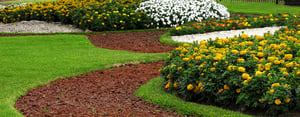What is Red Thread Lawn Disease?
As its name suggests, red thread disease manifests in stringy red or pink growths amongst your grass. This usually coincides with patches of affected grass turning brown. While red thread may look alarming, many lawns suffer some amount of it every year. Your grass will likely only be mildly affected and fully recover; however, runaway infestations can happen and need to be dealt with swiftly.What Causes Red Thread Lawn Disease
When exposed to the right conditions, the fungus spores of Laetisaria Fuciformis cause brown patch, dollar spot, and red thread. Spores spread quickly and potentially devastate your lawn. Red thread doesn’t like the heat but can increase when high moisture levels coincide with temperatures between the high 50s and mid-70s. This means you need to be on the lookout in spring and early fall. No Color No Color No Color How to Treat Red Thread Lawn Disease In almost all cases, red thread lawn disease can be managed. A few of our favorite techniques include:- Moisture control: As with just about all lawn fungi, red thread thrives in moist conditions. Aerating your lawn to limit standing water levels or sticking to a strict watering schedule can severely curtail its growth and spread.
- Proper lawn nutrition: Some lawn fungi prefer a nutrient-rich environment; red thread targets lawns lacking proper nutrition. Application of a balanced, nitrogen-rich fertilizer can resolve an infestation quickly or prevent one from happening at all.
- Dispose of lawn clippings: When mowing your lawn, it’s easy to forget about the clippings and just leave them out to decay. Doing this, however, increases both moisture and humidity levels on your lawn, allowing red thread to take hold. Just make sure that your mower has a proper clippings catcher and that you’re disposing of newly cut grass responsibly, though, and you’ll be fine.
- Overseed: Properly done, annual overseeding can help your lawn simply outcompete red thread. As lawn diseases go, it's not particularly severe, so a healthy, well-cared-for lawn can often shrug off a red thread infestation and bounce back without issue.
- Wait: It seems counterintuitive, but time may be on your side when dealing with Red Thread. Depending on the season, it can slowly diminish with changing temperatures. While this can be an effective strategy, it’s best done in conjunction with other preventative measures before turning into an infestation.
Unlike many other lawn ailments, red thread stands out. Its distinctive appearance makes it easy to identify, which is key for fast treatment. One of the more common seasonal lawn diseases, it’s likely that you’ll encounter red thread sooner rather than later. Knowing what to do when it shows up, though, is essential for proper lawn maintenance. 
When your grass starts growing red antlers, you know something is wrong! In this guide, our soil scientists explain how to prevent and treat red thread disease

.png?width=190&height=106&name=header-logo01%20(1).png)
.png?width=1142&height=1350&name=Holiday%20Decor%202025%20LP%20-%20548x648%20%20(1).png)


